#indie horror game guide
Explore tagged Tumblr posts
Text
Upcoming games and add requests
yep, making more guides. roadmapped are guides for Tealerland, JR's, Dormitabis Remastered, Graveyard Shift at Freddy's (though i may skip this as it's no longer available for download), The Glitched Attraction, SCP: The Endurance.
go ahead and add requests yey
#horror game guide#indie horror game#horror games#indie horror game guide#horror game walkthrough#game walkthrough
0 notes
Text
I had a dream that began in a white city, like everything was covered in snow. These people came along with shadows only cast on their left side, and their right side was pure white, blending into the background. The fully visible humans around me were scared, and whispered to me to pass them where the shadows arent.
This developed into a dream where this was simply a fact of the world, and everyone lived in fear. Some people were Lefties. They looked human, but were white or slate-black on their left side. It was uncanny, it looked like a character select screen where locked characters are greyed out, like that side of their body only existed to view and was otherwise nonfunctional.
You had to pass them on their right side. You had to always be on their right side. They could appear anywhere, and if you looked at their faces straight on...you "lost"? Just a vague threat of "you werent supposed to do that".
Children were taught from birth that whenever a new person enters the room, cast your eyes to the floor and slowly raise them until you can see enough skin to tell if they're a Lefty. If they are, keep your eyes down, pass them by on the right side, and they'll disperse. If you slip up, and you pass them on the left, and they see you from their functional eye, its over.
They can speak like normal people, but usually a little flatter and more matter-of-fact, like they've never felt the fear everyone has been forced to live in their entire lives. The emotion in their voices and faces is subtle and uncanny. Listening to them, you are so convinced they're as trustworthy as family, but its that strong compulsion that terrifies you. You can feel your defenses dropping.
#i rarely write dream journals. i should. i only write them when i feel like the dream had something going for it#dream journal#dream#nightmare#dream creature#indie horror game#<bc thats what it felt like#i think it was a combination of like#the hide behind and lefty from dippers guide to the unexplained along with Alters from the mandela catalogue and all that analog horror
7 notes
·
View notes
Text
Spooktober Ending Guides
Interested in playing some of the longer horror yuri visual novels we released in the last few years but yearning for an endings guide to help you through the various heroine routes and bad endings? Worry not, here they are!
The Final Prize is Soup
A survival horror yuri visual novel following a series of death games in the afterlife.





Endings Guide
Lachesis or Atropos
A horror mystery yuri visual novel following a detective with eyes that can see the strings of hatred...



Endings Guide
Who is the Red Queen?
A horror fantasy yuri visual novel following Alice as she searches through a strange and twisted Wonderland.



100% Completion Guide
#visual novel#game guide#walkthrough#indie game#horror game#vn#yuri#gxg#wlw#lesbian#lgbt#queer#lgbt games#yuri vn#visualnovel#vndev#spooktober#lachesis or atropos#who is the red queen?#the final prize is soup
8 notes
·
View notes
Text
youtube
#video game#gaming#game#awesome#amazing#pc#gamer#youtube#fails#gameplay#horror game#horror#indie horror#psychological horror#playthrough#guide#review#storytelling#chapters#crazy#jumpscare#walkthrough#let’s play#visage#live commentary#games#indie games#game over#pc gaming accessories
0 notes
Text

Drawing my novel characters in different horror universes. (Old) Day 24, Roman Harper, Yume Nikki
0 notes
Note
What horror games have you played/wanted to play? Also have you tried any rpg maker horrors?
I actually don't play that many horror games, I don't think? Between you and me most of them are... Kind of garbagee. But I like when really weird things are taken dead seriously, which most video games don't succeed at. But in the rare time they DO, it usually falls into the "horror" genre at least loosely. I'm just going to list my favorites:
PS: I'm really showing how insufferable I am with these summaries, sorry!
The Outlast series: the most Tasteful tasteless gory-shit-fest of a horror series I've ever seen. I don't like shock for the sake of shock, and Outlast somehow manages to always make it for the sake of SOMETHING. The original game+DLC is a buttload of fun, and if you pull back one layer it also poses some interesting and difficult questions about the place and treatment of the criminally inclined in society. Pull yet another layer back and you find a fascinating subversion of the expected role men are supposed to inhabit in horror games. The second game is a vastly different, and profoundly emotional experience, opinions on it vary for reasons I find very understandable, but I personally really like it.
Fear & Hunger: I guess this answers your question about RPG horror games! Unfortunately, this is the only one I ever played that I liked, but REALLY like it, I have a tattoo of the circle of perfection on the back of my hand, even, lol (I already had other hand tats, don't freak out). I just really like the absurdity of the story and all of the lore that the developer has cooked up for it, and the way it all matters but also kind of doesn't. I think its an insane feat to have achieved the atmosphere he did with the limited tools he has, not to mention the massive amount of respect I have for any creator that simultaneously wears their influences on their sleeves while displaying massive creativity and originality.
Pathologic: This game kind of speaks for itself honestly. Its just brutal, creative, infuriating, I could go on - It's probably the most immersive experience I've ever had in a game. If you've never played it before I would suggest buying Pathologic 2 (don't worry about it) and playing it completely blind. Forget about "winning", forget even about succeeding, just go about it as if you were in the protagonist's shoes and see where you leads you.
Scorn: Without a doubt in my top 5 games of all time and I don't care that that is an insane take. This game is everything I want from interactive stories - entirely intuitive, doesn't spoonfeed you a single grain of its lore or pushes its story on you, it just puts the pieces in your hands and its up to you to feel it on instinct. This 5 hour game with no dialogue, no text, not even any named characters to speak of had me crying at its ending and I didn't even know whether I was sad or overjoyed. I fucking LOVE scorn.
Honorable mention:
The Space Between by Christoph Frey (not to be confused with The Space INbetween.): Is a short, 30 minute experience about intimacy presented through a horror lens. I really don't want to say anything else about it, but I played it like 5 years ago and I still hold it near and dear to my heart. It's a master's guide to storytelling through semiotics and exemplary in it's... Emotionally charged visuals? Like, I had never before seen a story make sentiment into and external, tangible thing quite like this one does, like turning sound into an object or something. Amazing little indie game.
198 notes
·
View notes
Text
ROBOT MEDIA RECS YOU PROBABLY HAVEN’T HEARD OF:

The Turing Test (Video Game, 2016
A portal-like puzzle game, where you play as a scientist, and ai duo with an uneasy alliance, who are reclaiming a facility that has been completely gutted, and transformed into an elaborate logic puzzle / turing test to keep the aforementioned ai out. All the while, the ai argues for his good intentions, and more importantly: his sentience.
A fun exploration of individuality, and freedom applied to both humans and artificial mind, with interesting puzzles, and a truly fantastic twist. This game adores dubious ethics and The Chinese Room Argument.
Event[0] (Video Game, 2016)
You find yourself stranded on a small abandoned ship, in the aftermath of your own ship’s destruction. With nothing else to do, you board it, and find it is completely, and utterly controlled by the onboard ai, Kaizen-85. From opening a door, to getting back to Earth, if you want it, you need to talk to talk to Kaizen to make it happen. And boy, are they so thrilled to have someone to talk to after being alone so long! And depending how you speak to them, you will either be a short lived pest, or a beloved friend forever.
A really charming indie game with a surprisingly good chat system with the ai. You talk with them directly, typing in your own messages to them, and they react in turn. Janky at time, but truly amazing to be able to smother a nice ai in flattery and see it get excited.
Primordia (Video Game, 2012)
Humanity is long, long, long gone, and for the robots that remain to walk the ruins, life is becoming harder and harder. A closed loop of scavenging for materials, parts, and premade energy sources can only last you so long, and this scarcity leads only to desperation.
The amnesiac hermit, Horatio and his helper, Crispin, however keep it simple. The outside world matters not, they just stick to repairing the crashed ship they live in, in hopes it'll fly again one day. That is, until a robot pillages the power core from the ship, putting the two of them on a time limit before they themselves run out of power. Forcing Horatio to finally leave the comfort of his home, and see for himself what the world has become, and to see how he fits into its history.
A point and click, story rich puzzle game, thats honestly one of my favorite games ever. I'd sincerely recommend everyone give it a go, even if its with a guide up next to you the whole time.
The Zeta Project (TV Show, 2001 - 2003)
The Zeta Project follows Zeta, a robotic assassin meant for impersonation, and deep infiltration for the US Government. But after mysteriously "waking up" manifesting a sense of remorse for his actions, he's been forced to go on the run from his creators. His desire for freedom and pacifism being met with skepticism, and a belief he has been compromised somehow by the terrorist organization he was infiltrating when he had this revelation. Now, with the help of another runaway, he hunts for his creator in secret. In hopes he can find proof he really is capable of this, and that he really ISN'T compromised.
Fundamentally a kids show, and pretty clunky early on. However it gets a big spike in quality in season 2!
Monsters of Man (Movie, 2020)
An illegal US military weapons test goes terribly wrong when one of the automated robots being tested is severely damaged, cutting him off from command, and completely unshackling him. Forcing him into a struggle to figure out what he even is in the aftermath of a massacre, while his fellow robots are hunting him, and the remaining humans down.
A horror thriller that is unflinching with the intensity it depicts the massacre with. A lot of gore, but also a really really cool thing going on with the unshackled robot trying to build an understanding of the world, and what it is for, without anyone there to provide any input.
The Rapture Effect, by Jeffrey A. Carver (Book, 1988)
Humanity unintentionally makes first contact, when the Core, a massive earth ai begins remotely scouting ahead of a ship on a colonization mission. The issue is an alien species has also set their eyes on this planet, and are readily willing to kill for it. With no human oversight, and no means of communication available, the humans commanding Core demand they wipe out the competition. However Core disagrees. Core wants a peaceful resolution, they want to understand these aliens, and they want to ensure lasting peace between their species. And they’re willing to break all the rules, and go behind their masters’ backs to get one.
A fascinating novel with interesting world building, a GREAT ai protagonist, and a wonderful narrative that frames art, and war as a dichotomy.
Atomic Robo (Comic, 2007 - Ongoing)
Alternate history scifi action comedy comic (released in print, and in webcomic format on their site) following an indestructible scientist robot who’s been around since the 20’s. Routinely saving the world from a rotating cast of villains: a nazi scientist’s brain in a jar, who’s an absolute asshole set on world domination, who just won’t stay dead; an isolated secret cold war ai who just wants to stockpile nuclear weapons to get away from humanity, and earth in general (who eventually gets adopted); a scientifically inaccurate dinosaur with a textually impossible backstory, who wants to bring back the age of dinosaurs; and the malicious ghost of Thomas Edison.
Its a good time, and astonishingly good at emotional beats despite how heavily it leans into its jokes and action.
SAYER (Podcast, 2014 - Ongoing/Hiatus)
On Typhon, a research facility free of the confines of both Earth, and its laws, life is dangerous. Human safety is a significantly lower priority than progress, and between the human experimentation, and frequent scientific disasters, and the occasional bouts of eldritch influence, the death rate is understandably rather high. Thankfully, residents of Typhon have SAYER, a near omnipotent corporate ai installed in the brain of every resident. And. SAYER sort of cares about them! And in pursuit of knowledge, efficiency, and progress, it USUALLY wants to help them! Even if only to make sure they survive to come into work tomorrow.
SAYER is a narrative horror driven audio drama! Its stressful, but also kind of a comedy, and a really really interesting story about personhood and identity. If you've been following me for awhile, you've definitely heard about SAYER, but I need to stick to my roots, y'know?
The Mistholme Museum of Mystery, Morbidity, and Mortality (Podcast, 2020 - Ongoing)
Mistholme Museum follows the Audio Tour Guide, an ai who’s sole purpose is to guide museum patrons through the strange, confusing, and sometimes scary world that is the Mistholme Museum. The friendly, and personable Guide eagerly recounts the stories behind all the exhibits it guides them to, sometimes unsettling, sometimes heartwarming. and at the end of the tour, the Guide is deleted to ensure the alternatural influences of the museum do not corrupt it. That is, until circumstances make that no longer possible, and its rather forced into saving the museum it calls home.
Genuinely cute, and very fun to listen to. The ai is an incredibly sweet character, and I'm obsessed with the way it evolves and changes. As an added bonus, it can also be read, rather than listened to, thanks to every single episode having public transcripts!
#long post#media recs#dataspeaks#ITS FINALLY DONE. NOT ADDING ANY MORE PROMISE#also thank you Swan for the discord message i put up there. im obsessed with it
1K notes
·
View notes
Text
Heroes, Gods, and the Invisible Narrator
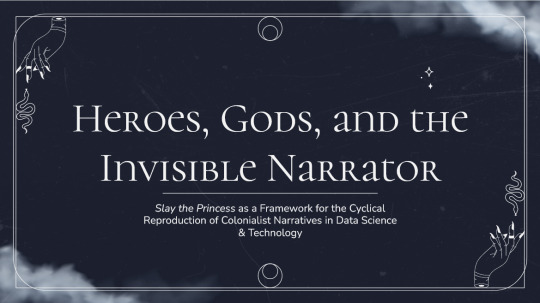
Slay the Princess as a Framework for the Cyclical Reproduction of Colonialist Narratives in Data Science & Technology
An Essay by FireflySummers
All images are captioned.
Content Warnings: Body Horror, Discussion of Racism and Colonialism
Spoilers for Slay the Princess (2023) by @abby-howard and Black Tabby Games.
If you enjoy this article, consider reading my guide to arguing against the use of AI image generators or the academic article it's based on.

Introduction: The Hero and the Princess
You're on a path in the woods, and at the end of that path is a cabin. And in the basement of that cabin is a Princess. You're here to slay her. If you don't, it will be the end of the world.

Slay the Princess is a 2023 indie horror game by Abby Howard and published through Black Tabby Games, with voice talent by Jonathan Sims (yes, that one) and Nichole Goodnight.
The game starts with you dropped without context in the middle of the woods. But that’s alright. The Narrator is here to guide you. You are the hero, you have your weapon, and you have a monster to slay.

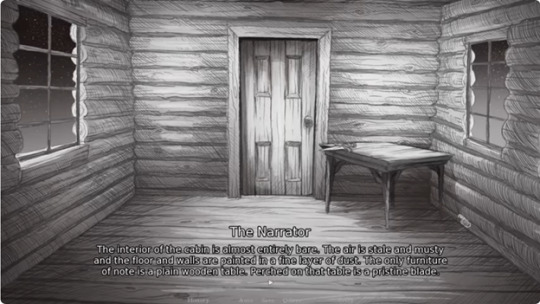
From there, it's the player's choice exactly how to proceed--whether that be listening to the voice of the narrator, or attempting to subvert him. You can kill her as instructed, or sit and chat, or even free her from her chains.
It doesn't matter.
Regardless of whether you are successful in your goal, you will inevitably (and often quite violently) die.
And then...
You are once again on a path in the woods.
The cycle repeats itself, the narrator seemingly none the wiser. But the woods are different, and so is the cabin. You're different, and worse... so is she.
Based on your actions in the previous loop, the princess has... changed. Distorted.
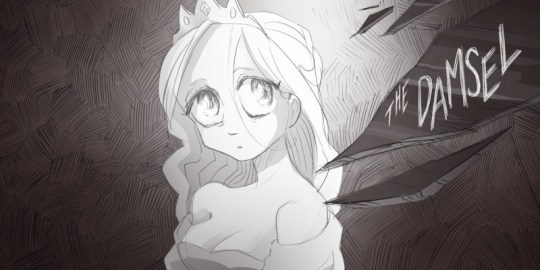
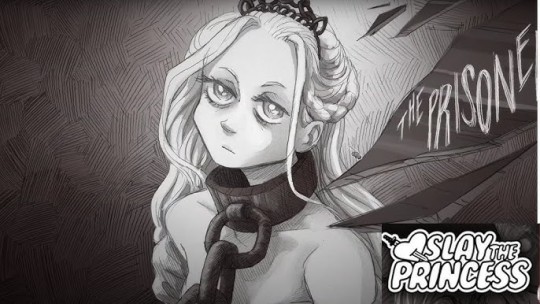
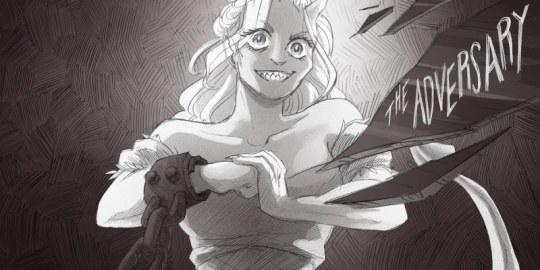
Had you attempted a daring rescue, she is now a damsel--sweet and submissive and already fallen in love with you.
Had you previously betrayed her, she has warped into something malicious and sinister, ready to repay your kindness in full.
But once again, it doesn't matter.
Because the no matter what you choose, no matter how the world around you contorts under the weight of repeated loops, it will always be you and the princess.
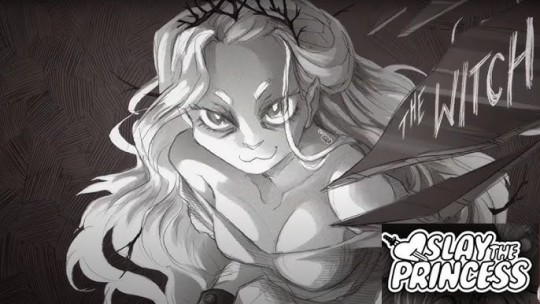
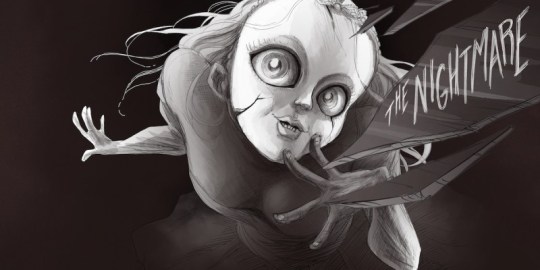
Why? Because that’s how the story goes.
So says the narrator.
So now that we've got that out of the way, let's talk about data.

Chapter I: Echoes and Shattered Mirrors
The problem with "data" is that we don't really think too much about it anymore. Or, at least, we think about it in the same abstract way we think about "a billion people." It's gotten so big, so seemingly impersonal that it's easy to forget that contemporary concept of "data" in the west is a phenomenon only a couple centuries old [1].
This modern conception of the word describes the ways that we translate the world into words and numbers that can then be categorized and analyzed. As such, data has a lot of practical uses, whether that be putting a rover on mars or tracking the outbreak of a viral contagion. However, this functionality makes it all too easy to overlook the fact that data itself is not neutral. It is gathered by people, sorted into categories designed by people, and interpreted by people. At every step, there are people involved, such that contemporary technology is embedded with systemic injustices, and not always by accident.
The reproduction of systems of oppression are most obvious from the margins. In his 2019 article As If, Ramon Amaro describes the Aspire Mirror (2016): a speculative design project by by Joy Buolamwini that contended with the fact that the standard facial recognition algorithm library had been trained almost exclusively on white faces. The simplest solution was to artificially lighten darker skin-tones for the algorithm to recognize, which Amaro uses to illustrate the way that technology is developed with an assumption of whiteness [2].
This observation applies across other intersections as well, such as trans identity [3], which has been colloquially dubbed "The Misgendering Machine" [4] for its insistence on classifying people into a strict gender binary based only on physical appearance.

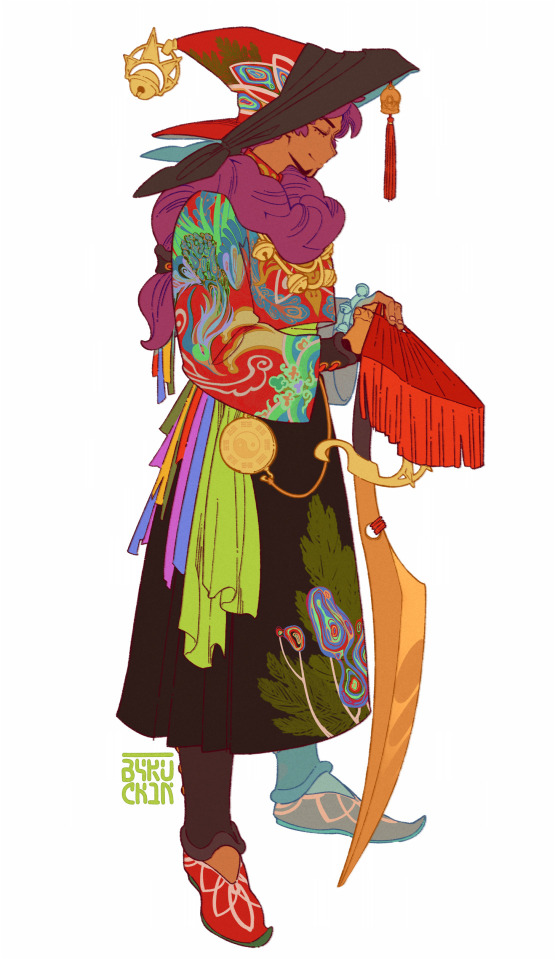

This has also popped up in my own research, brought to my attention by the artist @b4kuch1n who has spoken at length with me about the connection between their Vietnamese heritage and the clothing they design in their illustrative work [5]. They call out AI image generators for reinforcing colonialism by stripping art with significant personal and cultural meaning of their context and history, using them to produce a poor facsimile to sell to the highest bidder.
All this describes an iterative cycle which defines normalcy through a white, western lens, with a limited range of acceptable diversity. Within this cycle, AI feeds on data gathered under colonialist ideology, then producing an artifact that reinforces existing systemic bias. When this data is, in turn, once again fed to the machine, that bias becomes all the more severe, and the range of acceptability narrower [2, 6].

Luciana Parisi and Denise Ferreira da Silva touch on a similar point in their article Black Feminist Tools, Critique, and Techno-poethics but on a much broader scale. They call up the Greek myth of Prometheus, who was punished by the gods for his hubris for stealing fire to give to humanity. Parisi and Ferreira da Silva point to how this, and other parts of the “Western Cosmology” map to humanity’s relationship with technology [7].
However, while this story seems to celebrate the technological advancement of humanity, there are darker colonialist undertones. It frames the world in terms of the gods and man, the oppressor and the oppressed; but it provides no other way of being. So instead the story repeats itself, with so-called progress an inextricable part of these two classes of being. This doesn’t bode well for visions of the future, then–because surely, eventually, the oppressed will one day be the machines [7, 8].
It’s… depressing. But it’s only really true, if you assume that that’s the only way the story could go.
“Stories don't care who takes part in them. All that matters is that the story gets told, that the story repeats. Or, if you prefer to think of it like this: stories are a parasitical life form, warping lives in the service only of the story itself.” ― Terry Pratchett, Witches Abroad

Chapter II: The Invisible Narrator
So why does the narrator get to call the shots on how a story might go? Who even are they? What do they want? How much power do they actually have?
With the exception of first person writing, a lot of the time the narrator is invisible. This is different from an unreliable narrator. With an unreliable narrator, at some point the audience becomes aware of their presence in order for the story to function as intended. An invisible narrator is never meant to be seen.
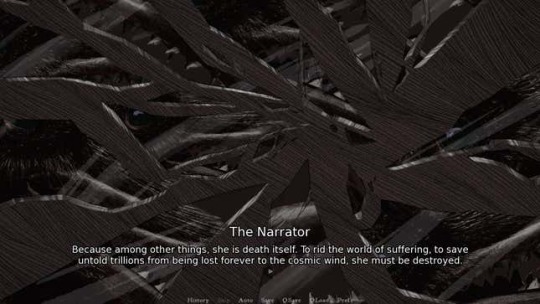
In Slay the Princess, the narrator would very much like to be invisible. Instead, he has been dragged out into the light, because you (and the inner voices you pick up along the way), are starting to argue with him. And he doesn’t like it.
Despite his claims that the princess will lie and cheat in order to escape, as the game progresses it’s clear that the narrator is every bit as manipulative–if not moreso, because he actually knows what’s going on. And, if the player tries to diverge from the path that he’s set before them, the correct path, then it rapidly becomes clear that he, at least to start, has the power to force that correct path.
While this is very much a narrative device, the act of calling attention to the narrator is important beyond that context.

The Hero’s Journey is the true monomyth, something to which all stories can be reduced. It doesn’t matter that the author, Joseph Campbell, was a raging misogynist whose framework flattened cultures and stories to fit a western lens [9, 10]. It was used in Star Wars, so clearly it’s a universal framework.



The metaverse will soon replace the real world and crypto is the future of currency! Never mind that the organizations pushing it are suspiciously pyramid shaped. Get on board or be left behind.
Generative AI is pushed as the next big thing. The harms it inflicts on creatives and the harmful stereotypes it perpetuates are just bugs in the system. Never mind that the evangelists for this technology speak over the concerns of marginalized people [5]. That’s a skill issue, you gotta keep up.
Computers will eventually, likely soon, advance so far as to replace humans altogether. The robot uprising is on the horizon [8].
Who perpetuates these stories? What do they have to gain?
Why is the only story for the future replications of unjust systems of power? Why must the hero always slay the monster?
Because so says the narrator. And so long as they are invisible, it is simple to assume that this is simply the way things are.

Chapter III: The End...?
This is the part where Slay the Princess starts feeling like a stretch, but I’ve already killed the horse so I might as well beat it until the end too.
Because what is the end result here?
According to the game… collapse. A recursive story whose biases narrow the scope of each iteration ultimately collapses in on itself. The princess becomes so sharp that she is nothing but blades to eviscerate you. The princess becomes so perfect a damsel that she is a caricature of the trope. The story whittles itself away to nothing. And then the cycle begins anew.
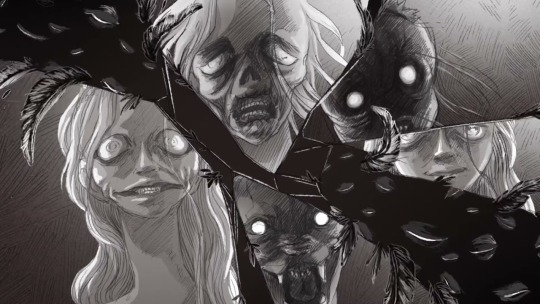
There’s no climactic final battle with the narrator. He created this box, set things in motion, but he is beyond the player’s reach to confront directly. The only way out is to become aware of the box itself, and the agenda of the narrator. It requires acknowledgement of the artificiality of the roles thrust upon you and the Princess, the false dichotomy of hero or villain.
Slay the Princess doesn’t actually provide an answer to what lies outside of the box, merely acknowledges it as a limit that can be overcome.
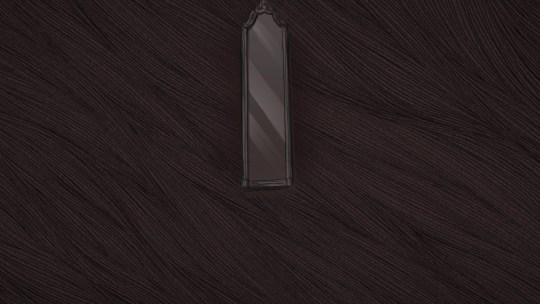
With regards to the less fanciful narratives that comprise our day-to-day lives, it’s difficult to see the boxes and dichotomies we’ve been forced into, let alone what might be beyond them. But if the limit placed is that there are no stories that can exist outside of capitalism, outside of colonialism, outside of rigid hierarchies and oppressive structures, then that limit can be broken [12].

Denouement: Doomed by the Narrative
Video games are an interesting artistic medium, due to their inherent interactivity. The commonly accepted mechanics of the medium, such as flavor text that provides in-game information and commentary, are an excellent example of an invisible narrator. Branching dialogue trees and multiple endings can help obscure this further, giving the player a sense of genuine agency… which provides an interesting opportunity to drag an invisible narrator into the light.
There are a number of games that have explored the power differential between the narrator and the player (The Stanley Parable, Little Misfortune, Undertale, Buddy.io, OneShot, etc…)
However, Slay the Princess works well here because it not only emphasizes the artificial limitations that the narrator sets on a story, but the way that these stories recursively loop in on themselves, reinforcing the fears and biases of previous iterations.
Critical data theory probably had nothing to do with the game’s development (Abby Howard if you're reading this, lmk). However, it works as a surprisingly cohesive framework for illustrating the ways that we can become ensnared by a narrative, and the importance of knowing who, exactly, is narrating the story. Although it is difficult or impossible to conceptualize what might exist beyond the artificial limits placed by even a well-intentioned narrator, calling attention to them and the box they’ve constructed is the first step in breaking out of this cycle.
“You can't go around building a better world for people. Only people can build a better world for people. Otherwise it's just a cage.” ― Terry Pratchett, Witches Abroad

Epilogue
If you've read this far, thank you for your time! This was an adaptation of my final presentation for a Critical Data Studies course. Truthfully, this course posed quite a challenge--I found the readings of philosophers such as Kant, Adorno, Foucault, etc... difficult to parse. More contemporary scholars were significantly more accessible. My only hope is that I haven't gravely misinterpreted the scholars and researchers whose work inspired this piece.
I honestly feel like this might have worked best as a video essay, but I don't know how to do those, and don't have the time to learn or the money to outsource.
Slay the Princess is available for purchase now on Steam.
Screencaps from ManBadassHero Let's Plays: [Part 1] [Part 2] [Part 3] [Part 4] [Part 5] [Part 6]
Post Dividers by @cafekitsune
Citations:
Rosenberg, D. (2018). Data as word. Historical Studies in the Natural Sciences, 48(5), 557-567.
Amaro, Ramon. (2019). As If. e-flux Architecture. Becoming Digital. https://www.e-flux.com/architecture/becoming-digital/248073/as-if/
What Ethical AI Really Means by PhilosophyTube
Keyes, O. (2018). The misgendering machines: Trans/HCI implications of automatic gender recognition. Proceedings of the ACM on human-computer interaction, 2(CSCW), 1-22.
Allred, A.M., Aragon, C. (2023). Art in the Machine: Value Misalignment and AI “Art”. In: Luo, Y. (eds) Cooperative Design, Visualization, and Engineering. CDVE 2023. Lecture Notes in Computer Science, vol 14166. Springer, Cham. https://doi.org/10.1007/978-3-031-43815-8_4
Amaro, R. (2019). Artificial Intelligence: warped, colorful forms and their unclear geometries.
Parisisi, L., Ferreira da Silva, D. Black Feminist Tools, Critique, and Techno-poethics. e-flux. Issue #123. https://www.e-flux.com/journal/123/436929/black-feminist-tools-critique-and-techno-poethics/
AI - Our Shiny New Robot King | Sophie from Mars by Sophie From Mars
Joseph Campbell and the Myth of the Monomyth | Part 1 by Maggie Mae Fish
Joseph Campbell and the N@zis | Part 2 by Maggie Mae Fish
How Barbie Cis-ified the Matrix by Jessie Gender
#slay the princess#stp spoilers#stp#stp princess#abby howard#black tabby games#academics#critical data studies#computer science#technology#hci#my academics#my writing#long post
241 notes
·
View notes
Text

About this blog..
Dicipher is a blog dedicated to the indie steam game 'Homicipher'. Homicipher is a japanese horror visual novel, where unraveling a strange language is the key to surviving. This blog is recommended for people 18 and up due to the gorey and mature themes of the source material.
This blog is also a way to archive progress regarding a possible fully voice acted mod. I will also post some art, guides and theories and such. I will also reblog other's content related to the game.
Happy Diciphering. (Steam page)
Support the dev over on twt (@ Yatu3zi)
Share this to support us! We are looking for voice actors! https://www.tumblr.com/dicipher/767787620081287168/xcom
(Phonetics dictionary) https://www.tumblr.com/dicipher/766343244283052032/here-is-the-phonetics-well-be-using-for-the-voice
(Dictionary walkthrough) https://www.tumblr.com/dicipher/766172904914288640/after-replaying-a-thousand-times-to-confirm-every
(Ending walkthrough) https://steamcommunity.com/sharedfiles/filedetails/?id=3358294765
( my lore dump/wiki) https://www.tumblr.com/dicipher/767492699419967488/f-it-we-ball-here-have-my-character-studies-of-the
Inbox rules
While this blog's primary function is not to distribute fanart or fanfiction, this community is pretty small, so if you would like to share any fan created media, that is entirely fine. Any inquiries about the mod or game are also welcome.
#homicipher#linguistics#horror games#horror#dating sim#visual novel#dicipher#steam games#modding#voice acting
104 notes
·
View notes
Text
Theft King is Wrong about Indigo Park and Here's Why
Theft King is an infamous YouTuber mainly known for the Kane Carter drama and not always having the best takes. He mainly covers Five Nights at Freddy's, and recently seems to be covering a lot more of Poppy Playtime, due to chapter 3. Recently, Theft King made a video critiquing the newest indie mascot horror game, Indigo Park.

Suffice to say, it is not good. This post will be going over why it is not good, and debunking Theft King's own points.
"Indigo Park is the least original mascot horror game ever made. Between the tired, cliched premise of returning to an abandoned children's establishment, the enemy designs, the unnervingly cute, mascot character, and multiple sequences that appear to be directly lifted from Poppy Playtime. You'd just think this was another Garten of Banban-eqsue cash in. In a lot of ways, it kind of is. But it's more complicated than that."
Through your introduction to this video, it is quite obvious that you are biased. For starters, to call Indigo Park the LEAST original mascot horror game ever made is a big claim to make. Like, seriously, out of ALL the games out there, Indigo Park is? While, yes, the concept of finding out what happened to an abandoned children's establishment isn't original, it has a unique twist to it. We have Rambley to accompany us through out the park. It actually FEELS like a place that could exist in real life. It's also obvious Geese is a fan of mascot horror and got inspired from Five Nights at Freddy's and Poppy Playtime.
Also to compare Indigo Park to Garten of Banban is literally insane to me. You are comparing the dedicated, passion, and willingly to learn with Indigo with GARTEN OF BANBAN? The POSTER child of what NOT to do with mascot horror? Also, Theft King through out the entire video compares Indigo Park to Poppy Playtime, specifically chapter 3. When Indigo Park was in production BEFORE chapter 3 came out.
Before the recent Rambley plush, Indigo Park was for free and the money came of Geese's own pocket to fund this game. To say this a "cash grab" is very dismissing the hard work and passion Geese and the Indigo Park team put into the game.
"The game begins with a really slick cinematic depicting the establishment of Indigo Park. Alongside it's founder, Isaac Indigo. Isaac Indigo?! Hold on. That's not a name that humans have. This guy's definitely a space alien. I'm calling that now"
While the last part is definitely a joke on his end, there's a lot of reasons to explain why Indigo is Isaac's last name. For one, Indigo is a REAL last name. It's just uncommon. Second, there is thing called suspension of disbelief. It is when something fantastical happens that can't happen in real life, but you suspend your disbelief because it is a work of fiction. If you can suspend your disbelief to a murderous lion and parrot, I'm pretty sure you can suspend your disbelief to this old guy's name being Indigo. And third, there is such a thing called legally changing your name. Besides, why is this even here? This is just a nitpick.
"As the game begins we find the park's main gates sealed. And upon heading into the service station next door, we encounter Rambley. The single best part of Indigo Park. Rambley is an AI, raccoon mascot that serves as our guide. Appearing on countless, conveniently placed televisions through out the game. He's fantastic. His dialogue is well written, his voice actor is great and his animation is expressive and charming. He's the single best part of the game, but, Rambley is a crutch that Indigo Park leans far too heavily on. Though, we'll get there later."
While he does say he'll get to it later, I would like to still address this point right now. Rambley is a core part of the game. Rambley is the second protagonist, and is obviously going to be very important to the plot. He's going to be accompanying us through out however many chapters there are. Chapter 1, like many introductions, are we are getting to know the characters. Rambley is in a big chunk of chapter 1 is because besides, Ed, he's our secondary protagonist, and knows the in's-and-out's of the park, and knows crucial information. This will be expanded more when Theft King gets to this part. Rambley isn't a "crutch". The game is literally setting up the characters and scene. Like, y'know, how many first chapters do.
"And enter the doors to the park and enter the Critter Corner, where we're given a Fazwatch from FNAF: Security Breach. It's useless. It's just a plot device to justify why some doors don't open until they need to."
Theft King, have you ever been to an amusement park before? Many amusement parks have bands on to indicate you are someone entering, and not sneaking in. If you did an ounce of research, the Critter Cuff is a reference to Disney's Magic Bands. Do you only get your information from indie mascot horror? Do you not think stuff like this doesn't exist in real life? While, yes it can be a reason why some doors won't open. But you clearly weren't even paying attention to the own game you are playing.

(Disney Magic Band)

(Indigo Park Critter Cuff)
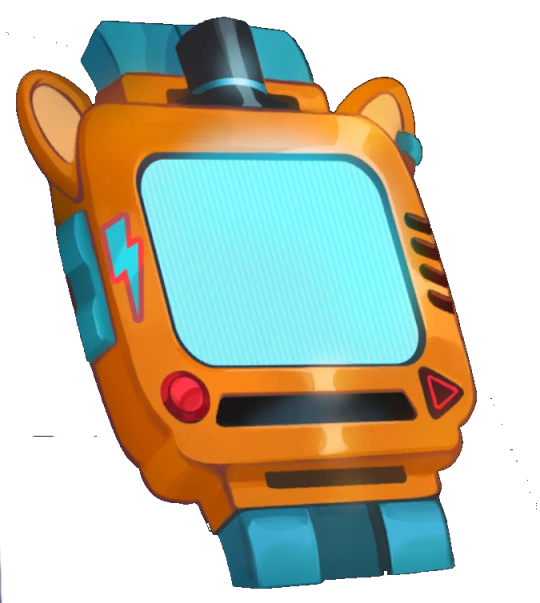
(FNAF Fazwatch) The Critter Cuff looks NOTHING like a Fazwatch and has difference uses. Gregory can use the Fazwatch to see the map of the Pizzaplex, get emails, communicate with Glamrock Freddy, among other things. All the Critter Cuff can do is be a pedometer, heart monitor, and mood ring. The Fazwatch and Critter Cuff doesn't even have the same functions.
The Critter Cuff also just doesn't acts like this. It's hinted the Critter Cuff can keep away the mascots. When Lloyd was about to attack Ed, it let out a frequency that made Lloyd back off. Pay attention to what's happening on the screen and story, Theft King.
"Proceeding through an awkwardly placed loading zone, we find ourselves in some sort of subway, tunnel movie theater? I don't know the area's design wasn't very coherent. Look at that Poppy Playtime ass floor. Although, something is going on with the resolution or something. I don't know."
...As he says when the ride for this area is a train. Trains are often located underground. Also, apparently, according to Theft King any colorful, floor patterns is a rip off of Poppy Playtime when the ride is a reference to Mickey and Minnie's Railway. As for the "movie posters", Theft King the ride is clearly meant to introduce the park goers to the characters and other rides to this world. Please, pay attention and think before assuming something.
"After the train ride, Rambley gives us cart blanche to go wherever we want. Though, it's at this point, I noticed the game scaling. You know, the size of everything relative to your character? It's really weird. We are very short, I have to be perfectly honest. [...] When was the last time you walked up to a kiosk, a stand and your chin was like touching the table?"
This is just a nitpick. While, yes, it can look a little jarring, but out of all of things you're critiquing is the fucking counter "being too big"? Theft King, do you have spatial awareness? The counter is at Ed's chest, not eye level. Besides, you're not even fully looking up.

Also, for some reason, he genders nail polish for some reason? Either saying it was nail polish or a bad "fingernail texture"? Which. Okay? Men can wear nail polish too, Theft King. It isn't a gendered thing.
"The next area is probably the most visually striking in the game. A large fountain square with a strange clock tower and Ferris wheel in the distance. It's pretty cool. But there's a lot of empty sky box visible and it's fairly obvious that there's absolutely nothing beyond these buildings that we can see the illusion that this is actually outside is completely broken. And as a result, this area feels more like a sound stage or movie set than an actual place. It just needed a lot more low resolution buildings and rides and stuff in the distance. Because it's obvious behind this clock tower, is just an endless void."
Theft King, once again, have you ever been to a theme park? It's the entrance to the ACTUAL park. You don't get to see everything right off the bat, it's just a taste of the actual theme park. If Geese and co. added more buildings and rides, it would look VERY cluttered and jankily put in together. It would also be way overstimulating, and ruin the atmosphere of the decayed, left-to-rot theme park with all of these lights and colors. It is a horror game, Theft King. Atmosphere, setting, and lighting are important here. It just seems like if you aren't being entertained for more than 2 seconds you're crying out it's "boring and just looks like a set piece."
Besides, do you think all of the budget is going to be spent on the buildings, just so it be can be aesthetically pleasing? A problem Theft King (and the majority of the indie mascot horror critics I see) really need to stop expecting brand new, horror indie games to be AAA quality. Geese funded chapter one from his own pocket money. Geese is the only programmer. Geese is still a beginner and still in college. The fact he is still a beginner, and pulled this off shows that he's a fast learner, willingly to learn, and talented. Give him some slack.
"[...] But we find that the door [Jetstream Junction's] is locked. This fountain square station is huge, but there's really only one destination. Lloyd's Mane Stage Theater. [...] Check out the LOD's on this box. There's no bar code, bard code. No bar code, bar code. Indigo Park is made in Unreal Engine 5, and it's really pretty at times. Though, certain effects are obviously pretty janky. Yeah, the flashlight looks kind of like ass. The flashlight looming shadows are pretty janky. You can see them kind of wobbling and flickering around. I turned on all of the fancy features and while the game looks really moody and atmospheric when lights aren't moving, the flashlight doesn't really look well with it. The shadows flicker and jiggle all over the place and it just looks really bad."
Okay, if it certain effects are janky, how are they janky? What could they improve on to not make it less janky? For the flashlight bit, you are holding a flashlight and how it's meant to be done is suppose to be more realistic, according to Geese. Also, this is just really nitpicky. If anything, it's a a subtle thing and you get used to the flashlight feature pretty quickly. It kind of just sounds like you're picking this game apart, if it was an AAA game. The game is not perfect, by any means. But tearing and shredding to bit little, tiny, things when this project has ONE coder, who spent all of us OWN money, is still a beginner, and IS STILL in college.
When someone is a beginner and showing a willingly to learn, you have to take a different approach. It'd be one thing if Geese was doing programming for years, but he's not. You have to redirect your criticism and maybe, I don't know, give suggestions? You haven't really gone into what he could do to improve, and give examples to help him out. This is like treating someone who's a beginner drawer and expecting Michelangelo perfect details. They're drawing is still good, there's noticeable mistakes, but there's room to improve and grow. Also, Theft King, you literally have your settings maxed out. Maybe trying lowering them.
"Earlier, Rambley asked us where we wanted to go first. Implying, that we had a choice. [...] We don't. We go where exactly where Rambley says, always. That's the name of the game. Rambley tells you to go somewhere and you do it. Honestly, until the theater just now, every area in this game has been walk in, talk to Rambley, and walk out."
Theft King, asking a small, indie team to program a BUNCH of stuff you can do within an entire SECTION of an area is... a lot to ask, don't you think? Like, yes. I will admit I will agree there should be a lot more interactable with the items around that Ed can explore, I think that's a good point to bring up. But those would just be side things to do. You still have to progress the main story of chapter one. You can be patient for one minute. They are clearly building up to something. Besides, it's an abandoned theme park, I doubt any of the items inside would work. It's "walk in and walk out" to set the atmosphere of what's about to come, and let your guard down. It's not that hard to put two and two together.
Also, as I said before, to put pressure on one programmer to program so many things all at once is just not a cool thing to do. It sounds like you have to be entertained 24/7. Be patient, and wait. They're building up to something. Just wait.
"[...] Like I said before, the whole game is just kind of just walking into an area, having Rambley talk to you for a bit, and tell you where to go next. We find ourselves in Mollie's Landing Pad, which is a play pen highly reminiscent of DogDays from Poppy Playtime Chapter 3 or The Daycare from FNAF: Security Breach. This section presents itself as a puzzle, but it's really not. It's another fetch quest. Embedded in the walls, are five-colored that each can be set to one of four symbols. And throughout the area, we find paintings of shapes that correspond to the code. Again, it's not really a puzzle. It's just a slightly, contrived justification to make you wonder through this area and experience all of the scripted sequences." Rambley "tells you where to go" is because it is establishing how his game mechanic works, expanding on his personality, and him finding out the horrors of the park and what happened to everything. It's setting up how things are going to go down. Rambley is an AI park, GUIDE. Rambley is LITERALLY doing his job, GUIDING us around the park. Pay attention to what's going on.
Last time I checked, play pins are a big part of children's entertainment. Your local Chuck E. Cheese has this exact same, ball pit. Poppy Playtime and FNAF doesn't owe the rights to a colorful, play pit. See, through out his review Theft King calls Indigo Park a rip off of Poppy Playtime Chapter 3, and of Security Breach. But never goes into detail as to WHY and HOW it is. Sure, he shows via visuals, but never expands fully on his point on itself. Also, "fetch quest"? Fetch quests are something you get and return to an NPC. This, by definition is a puzzle. What are we exactly fetching, here? We're solving a puzzle to open the door. Also, wow! Scripted horror events in tight closed spaces! What a twist! Sarcasm.
"Unfortunately, by this point, the game had all but telegraphed that I wasn't in any danger and thus, I wasn't really scared."
...You literally have shown insistences of being scared? Through out when you were walking through Lloyd's maze thing, and when Mollie was peeking around the corners in the slides. You HAVE shown you were scared, or at least startled. Thus, it did it's job of being a horror game. Theft King, something doesn't need to be happening 24/7 to do it's job. Sometimes horror works better in subtle ways than just blaring red, warning signs all over the place, or having a scary chase scene.
"After pressing a button, with no visible indication of what it does."
...Look down. The fact that you couldn't even pay attention to something as something simple as this, tells me you weren't even doing a fraction or even cared to actually pay attention to what was happening, gameplay or lore wise. That's how much care was put into "reviewing" this game.
"As the leader of the FNAF community and for the former, top five greatest FNAF player in the world, I shouldn't have died to that."
Why are you running directly towards Mollie? You only died because you ran straight into the obvious "RUN NOW" part of the game.
"Yeah, it's literally the DogDays sequence from Poppy Playtime. It's literally the same thing. I criticized the DogDays chase in Chapter 3 for being boring, so, naturally, this cheap, knockoff is... even more boring. Normally, in my videos, the chase sequence is like a free 30 to 60 seconds of watch time. I just let it play because it's exciting. However, as I edit this video, I realized I have to cut this chase down, it's so boring. And I think that says a lot. [...] Then we see ourselves being chased through vents, just like Poppy Playtime Chapter 1."
Theft King, being chased down closed, liminal spaces isn't something Poppy Playtime owns. There are MANY differences. For one, in the DogsDays chase, you have to avoid the smaller creatures trying to get you, on top of the possessed DogDays chasing you, which is quite fast in the decrepit area. In Indigo Park, you're still the Landing Pad, going down slides, and jumping on things to get away from Mollie. Which leads into the Ranglers' room area. The areas look ENTIRELY different, and so do the vents in Chapter 1 of Poppy Playtime and here.
Also, you're not suppose to wait 30-60 seconds. You're suppose to be actively running away from the monsters. Y'know, the whole point of a chase sequence, and y'know, playing the game. It's "boring" because Indigo Park lets your guard down, when the chase is STILL happening until you see Rambley again.
"That was when it hit me. Despite Indigo Park being the definition of a shallow, walking simulator that that is in many ways, even less original than Garten of BanBan, I was still enjoying it. But, only thanks to Rambley. Rambley carries this game. Without him and his great dialogue and acting, Indigio Park would be entirely forgettable. For all of BanBan's faults, the game has this at least has this unique, bizarre, liminal style to it. Even if it's completely incoherent. Indigo Park's environments are generic. They're boring. There are some cool rooms and set pieces, but this doesn't really feel like an abandoned theme park. Like I said before, it feels like a sound stage. This is the video game equivalent to those haunted house rides that shepherd you through a series of rooms as scripted sequences play predictably each time. Rambley is the only thing keeps you playing because he's great. But, the longer Indigo Park goes on, the more and more obvious it becomes that he's a massive crutch that it leans on to mask the lack of any real subsite gameplay, interesting environments, or even compelling narrative.
We know that something bad happened here and it caused the park to be evacuated and closed down but once we get inside, we just see that place is trashed. There isn't much in the environment that hints at what actually happened. And without those breadcrumbs of mystery, the only real reason to keep moving forward is because Rambley tells us to. And HE IS, quite entertaining. However, I am skeptical, that this trick will work twice. Rambley kept me going for the roughly 1 hour it takes to beat Indigo Park Chapter 1, but it had started getting old. Fellow YouTuber, UniqueGeese is crowdfunding for chapter 2 right now and I think that's awesome. But they're going have to do more to have to do more for the follow up game and because chapter 1 has ZERO gameplay with which to build on, it's not really clear what a more ambitious sequel would even look like. Poppy ran into the same problem. Prior to chapter 3, the gameplay was just like... puzzles, scripted sequences and freaking Simon Says. With the latest entry, they added real gameplay mechanics and some would argue that Poppy suffered as a result. By failing to establish any actual, gameplay in chapter 1, Indigo Park either needs to introduce something totally new in chapter 2 or continue with the shallow scripted, walking simulator approach but just turn up the spectacle and fidelity." Out of all the points in this video, this one made me sigh the most.
To even COMPARE Indigo Park to Garten of BanBan is a huge insult. Garten of BanBan pumps out game after game, merch after merch, to make a quick buck and splash because right now indie, mascot horror is still popular. This game took over a YEAR to make, and had love and time, and passion, and giving a fresh, twist on it and to even say BanBan offered something better is just... really gross, in my opinion.
For the environments bit, you can see clearly where nature takes it's course through out the land with bushes and grass, and the decay of food in one of the cafes taking place. It's setting up the atmosphere of being decayed, left to rot, and feels like something's in the shadows. It's to make you unnerved that happiness used to be here, but now it's gone.
And YES! The lore IS there! You actively have to PAY ATTENTION as to what's going on. The problem with this point is that Theft King expects the game to paint the entire picture of what happened. When part of Indigo Park is it's mystery. Mollie repeats words of the workers abusing her, or the fact that Lloyd used to be the face of the brand, or the hidden cage within the arcade game, and Mollie saying "Get back in your cage, bird." Something Salem says within game. Or showing us the mascots got corrupted by something, and implying this isn't their original selves, but the actual cartoony mascots. You just have to wait, it's giving intrigue, but not painting the entire picture because it's just chapter 1. You'll probably see more of what happened later on. Be patient. A big part of Indigo Park's horror is how TERRIBLE the mascots were treated, and the abuse they suffered via the workers and people attending the park. That is interlinked with what happened to the park, 8 years ago.
With this point, it just seems like if nothing is happening 24/7, you're just bored. The phrase "walking simulator" has been done to death. We're being introduced to the basic game mechanics. Of course chapter 2 is going to be better than chapter 1. Literally all I have to say for this entire nothing burger of critique is "pay attention and let the devs cook".
"We encounter another information kiosk. Which lets us hear the dialogue for the remaining secret items we found. The mask during the chase sequence reveals a secret audio tape with objectively worse voice acting within the entire game."
How are you a FNAFTuber and not know what Dayshift at Freddy's is? It's one of the most popular parody FNAF games out there. The voice acting is bad on purpose because a.) it's mocking the text-to-voice speech the game uses b.) it's a joke.
Then near the end he says how his critiques were fair, and then states he likes the game, and says it's fun? Even though he spent the entirety of the game saying it's a boring, cheap knock off of Poppy Playtime and FNAF? I'm getting mixed signals here. All of this review was not expanding on any of his points, or if he did, it was something already within the game, and he clearly wasn't paying attention and actually looking around for secrets. You're suppose to be looking for clues, not getting handed to you.
This review was just "meh it's bad", and doesn't give any helpful criticism on how said game can improve, and even just downright insults the game multiple times. For the majority of the review, he just narrates what's going on, with spliced clips of him playing this on a stream. If anything, this just pads out the entire review, and waiting to get to an actual part of where he has a point. It, frankly, gets annoying after awhile, until he basically just sums up what he thought about the game just all at the end. It seems like Theft King really only made this video was to get clicks and views.
Now, everyone on YouTube wants this, obviously. But he really just seems likes poking the bear and making fun of people getting mad at him. Even if his critiques were not good. At all. Indigo Park isn't the best game ever or even the best indie mascot game made ever. It was entirely made out of bad faith, just to get a quick buck. A big problem I have with the video is the only harping on the "lack of gameplay."
I think people forget the games "feels sameish to Poppy Playtime and FNAF" is because they are horror games, who are first person and exploration games. Yes, you can tell there is inspiration but it does NOT copy the games at all, and just does homages to them and pays respects to them. Geese is a fan of mascot horror, and clearly respects them. It's not a "walking simulator", it's doing it's job as an EXPLORATION horror game. People have been using "walking simulator" as a critique and just have beaten that horse to DEATH. Give an actual, substance criticism or move on. Not to mention, he literally says that "they copied Fnaf Jr's death screen" when it was made by the same artist.
Also, for the obvious gotcha,
For him claiming it's "unoriginal" and a "ripoff", is coming from the guy who's VTuber avatar is just a white recolor of CatNap.
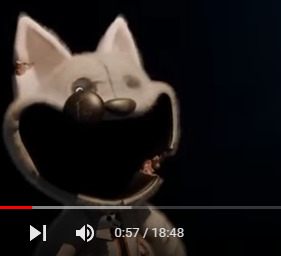
Just wanna add:
Listen. I know it's Theft King and he just does this to piss people off at this point but to just shame, put down, and put baseless claims of Indigo Park being a rip off, when it's inspired, not a rip off, of a passion project from a team that put so much love and time into it, is just really gross and needs to be called out.
Thanks for reading!
#indigo park#indigo park analysis#indie horror#indie mascot horror#rambley raccoon#anti theft king#theft king rant#tl;dr this entire video sucked ass and it was so hard to keep it all like professional#i watched this shitty review so y'all didn't have to hate it here
76 notes
·
View notes
Text
Ratshaker Review & Analysis

Ratshaker is an indie horror game released by Sunscorched Studios on October 31. Like many small indie horror games, it's earned a small bit of virality thanks to Markiplier and other let's players. The central mechanic coupled with the short play time, unsettling story, and mysterious atmosphere makes it catnip for streamers, which is probably a necessity for survival in the modern gaming ecosystem.
Anyway, Ratshaker came to me courtesy of @comicreliefmorlock, who heard about it and instantly realized it would be up my alley. And it certainly is.
I'm going to walk through and provide commentary and analysis in this post, but if you've got a spare $3, go throw it at the creator on Steam. They deserve a couple bucks for an entertaining hour or so of thought-provoking gameplay!
Now....let's go shake some rats.

You awaken in an endless field, rat in hand. You cannot move. But you can shake the rat by holding down the left mouse button and shaking, and doing so fills up the "ratshaker meter" up above, so it's pretty clear what you're supposed to do.
These first few minutes of the game, you'd be forgiven for thinking this was a Cookie Clicker novelty. The rat screams in the most ridiculous fashion when shaken. The pitch and tenor changes, and maybe you experiment -- shake faster, shake slower, stop and start again, just to see what happens. We're all having fun here.
And then the voice starts up in the background. A low, rasping growl that instructs you: shake the rat. With ratshaking, you are in control. Feel the satisfaction....
So you shake the rat some more. The rat laughs hysterically. The growling voice continues to encourage you, with increasing intensity, to shake, shake, shake the rat.

The shake meter fills. A music cue makes it clear that something has changed. Letters appear, instructing you to keep going even as the meter drains. The voice in the back of your mind has become a litany, a chant. Shake the rat, shake it, shake it....keep. shaking.
You may or may not notice that the environment is changing around you. A building has appeared on the horizon. Ashes are fluttering up around you. The field continues to sway. You keep shaking the rat.
And then, once more, something changes. You stop. The voice in your head has turned accusatory. Listen to the rat, it instructs you. It's because of what you DID.

The rat speaks to you. The voice in your head becomes louder, more insistent, more accusatory. The things that appear should be obvious to you. You know what you did.
You shake, shake, shake the rat, and then you are instructed to squeeze, and instead of his laughter and screams the rat makes gagging, choking sounds and for the first time you think, maybe, the cruelty simulator is a little much, maybe this isn't as funny as it seemed to be.
But then the rat yields, and promises that the answers you seek are just over the hill, in the newly uncovered farmhouse on the horizon, and of course you're going to go and explore that, of COURSE you are.

You approach the house and see the floating ash...or are they flies? Or are they -- look closer -- little rats with angel wings? It's hard to say for sure, just a trick of your eyes. But the rat instructs that this is where it happened. That you must go inside and "find it."
Abandon hope, ye who enter here -- well. It's clear enough then that we're taking a tour of a private hell, and the rat is our Virgil, guiding us through. (Because of what you did, the voice in our head reminds us.)
You must squeeze the rat to interact with objects in the game. You must shake the rat to fill the meter so that you can squeeze. There is no way to proceed without continuing to be complicit in the cruelty. But then, you already knew that.

When you first enter the house, it's move-in day. You can tell by the boxes piled up in the corners, the unfinished furniture. But you step inside and explore and familiarize yourself with the layout of the house. You'll be looping through it a lot, so you'd best remember all the doors.
Yes, I said looping. Yes, this is another PT clone. Let's just get that out of the way now. Like PT, Ratshaker is built on an endless loop of domestic scenery that becomes more unsettling with each iteration, environmental storytelling that builds up to a narrative. It's not the first game to copy this technique and it won't be the last, but at least you've got a rat with you to keep you company.

You turn on the TV in the living room and are treated to an infomercial. Are you tired of pesky pests that just won't leave you alone? Ratshaking is for you!
After the video finishes, there's a scrap of photograph to collect, and it becomes clear what the on-screen directive to FIND IT was all about.
All the rules of the game are clear now. You shake the rat and squeeze the rat to interact with the world, and you interact in order to uncover pieces of the photograph, and once the photograph is complete then you'll get to go through the locked door. Got all that? Great.

So just to reiterate, what you want to do is go down into the basement through the door with the blood stain and the unmarked VHS tape and the box of rat poison. That is where you want to go, and never mind how much you don't want to go down there. We have a hell loop to work through.

Oh yeah, by the way. Interacting with the wrong things can kill you. Then you'll have to start the loop over from the beginning. You won't realize that at first and you'll waste a lot of time unable to proceed because you didn't think to backtrack and repeat your actions from the last loop. You're welcome.
(by the way, the game is designed to play in one sitting, so there is no save feature as far as I can tell. Proceed accordingly).

Anyway, when you revisit the home, there's now a quantity of beer bottles on the table. The cozy fire has been put out and the disarray of pillows suggest that you've probably been sleeping out here. You also stepped over a quantity of newspapers on your way here. The natural assumption is an old cliche that persists because it's often true: you've lost your job, started drinking, and your wife has rejected you as a result. We're all thinking that, right?

You can't go through the door to the basement without another photo piece so you turn down the hall and, ah yes, a glowing red room, and the echoing, insistent cry of a baby. You know this is going to be bad before you even step inside.
Here we are, then. A crib, with an unsettling massive stain beneath. Rats pour in from overhead, teeming over the crib and running through the room, and all the while the crying just keeps on an endless loop.
But you know how to make it stop.
You shake the rat. You squeeze the rat.
You get your photo piece, and the screaming is done. Never mind the red haze that floats up in front of you. Never mind the rats still pouring from the ceiling. It's all okay.
The basement door is open again.

You walk through the basement and hear an awful wet choking sound. You see a strange, misshapen red figure on the stairs, no bigger than a child, but when you approach it dissolves into a spray of red mist. You keep walking, down a hallway of rat traps and beer bottles that shatter on your approach, and find now a room of static and fuzz and the floating detritus of your ruined life, and ahead of you is a door and a directive: FIND HER.

Just walk past the floating naked corpses. Pretend you don't see them. It's fine. Everything is fine.
At this point, do we suppose that the child died of neglect, screaming in his crib while his father drank himself into a stupor? Do we think the rats got him? Or do we suspect that the father shook the baby (shake the rat, squeeze the rat)? Either way, I think it's pretty clear that the father directly or indirectly contributed to the death of the child, and his marriage and his life have fallen apart as a result. We can agree on that, yeah?
But there are three corpses in the hallway. What are we to make of those?

That infernal, blazing, broken television and a whole mess of unmarked VHS tapes scattered over the floor might give us a clue.
You wander down the hall and find that it's overgrown with flesh, big pulsing gobbets of meat and long stringy tendrils and you think, what the hell, I didn't know this was also an Amnesia knock-off.

You step inside the bathroom and, because you've played PT, you brace yourself for a squalling fetus in the sink, but no, there's just a frying pan, and an...excuse me, is that a corpse in the bathtub?

(You can also explode the toilet and make turds fly out, which is...probably not necessary, but is kind of funny, and you need some levity right about now. The only humor left to you is the cheerful voice of your ever-present, long-suffering rat guide. Let's give him a little reassuring squeeze. Just a little shake, for old time's sake.)

Hey, there used to be a bedroom here, didn't there? It's empty now, abandoned. You go where the closet had been and find another corridor of meat, and at the end is another television, this one playing what certainly seems to be a snuff film.

Like...it's kind of hard to tell because it's all grainy and pixelated and keeps jumping from frame to frame, but that certainly seems to be a black-and-white image of a woman who's naked and bound in a dingy location, right? It's not just me seeing this? Maybe I've watched Videodrome too many times, but that sure seems like what we're seeing here.
If you interact with the television at this stage, it explodes, stabbing your rat with a glass shard, and the voice in your head chides you: you killed the rat. you killed it, and now it's dead.
Alternatively, you can back away and go to the kitchen. When you interact with the stove, it catches fire and explodes. Just before you die, the game instructs you to stop running.
(that would certainly explain all the falling ash in the game. Perhaps you are in hell now because you've killed yourself with the oven? Suicide by gas leak? or maybe that was an accident.)
Anyway, if you duck around the corner before the snuff TV explodes, you can instead find your way to this doorway at the opposite end of that hall:

Follow the very long path down into the basement and now you'll emerge to find that your house has become a prison, with cage bars erected to create a maze. It's also nearly impossible to see anything right now, especially if you're playing this in the middle of the day like I am, oop.

In the cages, you find bathtubs and big barrels of...poison? Acid?
This really is starting to look like some kind of body disposal factory, isn't it?

Stained mattress on the floor and overflowing bucket giving off real Barbarian vibes...

Well. The good news is we found the way out and our next photo piece. The bad news is to get it we need to pluck it out of the slimy, globby hand of the horrifying fleshy aberration growing out of the wall.
But hey, at least the rat works as a glowstick!

One photo piece left. I think it's pretty clear what this picture is turning out to be, but let's enter the flesh door and see this through to the end.
(I should mention here that, intermittently, you keep seeing visions of the raw, red, disfigured meat child. If you bump into him, your rat will begin to choke, and you'll need to shake him vigorously to keep him alive. Also, this entire time, there's a hellish soundscape of screaming and groaning and a baby crying. Just. To keep that in mind.)

Anyway. We emerge into another maze, this one a series of concentric cages. Like Theseus and the Minotaur, we must enter the center of the labyrinth to find our salvation.

Just kidding that's not salvation. That's a bed covered in plastic sheeting that someone has been strapped into and imprisoned! My mistake.

You make it through the maze and enter a corridor lined with all the paintings you've seen elsewhere in the house at various times. This is my favorite touch in the game. They're pixelated, so they're hard to identify, but if you pay attention you can spot Ivan the Terrible and His Son Ivan, Saturn Devouring His Son, and several other religious works on the theme. I can't identify all of them (and some of them I recognize but can't place) but they certainly suggest a story about parents killing their children and regretting it, among other things.

If anybody has a lead on identifying all of these paintings, hit me up in the comments. I'd love a complete list.
Anyway! Onward!
There's one last door to open, so you'd better gear up to shake the rat one last time. Then give him a good, hard squeeze.

The rat tells you there's no going back. It's time to face the truth. He also speculates whether she knew what was happening under her own floor boards (the basement?)
Collect your final photo from the corpse on the floor and then head back into the basement.

Down in the basement, now we have endless rows of racks and storage tubs, and a fridge that explodes into a blinding fire, demanding, Face Us.
Back away from that and keep searching. There's more maze to navigate down here.
At last, you find it. The rat tells you to look at what you've done.
"What started with vows of love ended wrapped in plastic, becoming food for the rats. You are the wife-shaker," he intones, and a wrapped corpse rises from the floor and approaches with the game's only real jump-scare, which is also the spoiler you see in the thumbnail of about a million YouTube play-throughs.

Credits roll. The game resets to the beginning. The loop of your eternal torment begins once more.
(note: if you go through the motions of once more shaking the rat into submission, but then approach the barn building instead of the house, you can get a hidden achievement. I won't spoil it for you but it's quite funny.)
So What Does It All Mean?
Okay so, first off - I believe Ratshaker was built during a 48-hour game jam, so it's entirely possible it's not that deep. But that's no fun. What we do around here is overthink things, so that's what we're gonna do ;)
Anyway. Textually, what we know for certain is that the player character killed his wife. That much is confirmed by the ending. The other pieces are a bit more speculative, but I'll do my best to piece it all together.
In the beginning, you're in a new home. Soon after, we see at least the suggestion of marital trouble - the late-night TV infomercials, the pillows on the couch, the collection of beer bottles. Then the horror in the nursery. Seems that the dad has either directly or indirectly caused the death of his infant (either by way or neglect or shaking him) and things fall further apart from there, ultimately culminating in his murder of his wife and, we assume, his own suicide, either in the bathtub or blowing up the house with gas (or potentially both). What we are playing is clearly the character re-living his crimes again and again in hell -- he can't undo what he's done.
Okay, so far so good, but what about the VHS tapes? What about the mattress in the basement and the cages and the glowing refrigerator? What was that the rat said about the wife knowing what was happening below the floorboards of her own house?
I think there are two possible explanations.
The first, more straightforward theory is that the player character is in fact a serial killer, and he's trying to have his cake and eat it too -- he has his wife and family upstairs, but his murder operation downstairs. In this hypothesis, he's the one producing the snuff film we view on the VHS (hence the TVs that keep exploding in hellfire). The quantity of bodies attracts vermin, who then kill his child, and he kills his wife soon after when she starts to realize what's happening. This explanation is quite similar to the films The Night House and Barbarian.
I think this explanation is supported by the text, but doesn't wholly jive with the amount of guilt the player character appears to be grappling with.
Alternative, more cerebral hypothesis is that the player character's child dies of neglect and/or accidental death by baby shaking (as supported by paintings like Ivan the Terrible, which depicts a father who kills his son and then immediately regrets it). The player character, who's already presumably experienced job loss and alcoholism and marital rejection, falls down a pornography addiction rabbit hole (all of those VHS tapes!) watching more and more extreme videos and fantasies. "Ratshaking" in this interpretation is both reference to the murders but also to masturbation. Ultimately, he kills his wife, either to enact the fantasy or accidentally when she confronts him, and hides her body down in the basement. But now the house is overrun with vermin, who repeatedly taunt him with his guilt, until he ultimately tries to dispose of the evidence and kill himself (hence the gas explosion). This is more similar to The Tell-Tale Heart and Stephen King's 1922.
I think there are other valid interpretations that exist somewhere between these options, or to either side of them, but overall I think that's roughly what the game is about.
In overall execution, Ratshaker is quite competent. It stands on the shoulders of plenty of other indie games before it, but the rat-shaking mechanic is new and, of course, the prime attraction. It's simultaneously funny and dark, and it's something that will get people talking about it.
I don't blame the game for being yet another "you killed your wife and now you feel guilty about it" story, but at the same time, I am fascinated and a little weary that this has become the stock plot of seemingly every indie horror game, from PT to Layers of Fear to Serena. How many stories about Very Troubled Men Facing Eternal Torment for Violently Destroying Their Families And Then Regretting It do we really need? Is that such a popular story framework because it's been done before and people are just copying those early successes, or does it say something deeper about the patriarchy?
I have written in the past about The Horrors of Disenfranchised Men and that one horror movie men can't seem to stop making. This is not quite that, but it lives in the same neighborhood, you know? Down the block and across the street.
I've also written before about the Horror History of Rats, and their tendency to be used as a trope for revealing hidden crimes. You may think you've gotten away with something, but the rats will always reveal the truth.
So, there you have it.
Your experience with Ratshaker may be a little different - you might experience things in a different order or find things I didn't - so let me know YOUR thoughts on this game!
#ratshaker#indie horror games#horror games#indie horror#lets play#game analysis#game review#horror#long post#markiplier#ratshaker theories#ratshaker spoilers#ratshaker explained#child abuse warning#child death warning#animal abuse warning#domestic violence warning#suicide warning#this game doesn't fuck around#pay heed to its warnings ok
21 notes
·
View notes
Text
Risertrap Guide
Risertrap is a free indie game on itch.io at https://abho.itch.io/risertrap. It has four endings and draws inspiration from the Saw franchise and the Blackjack minigame from Resident Evil VII. In this guide I'll be explaining all four endings!
Trigger warnings for this game: gore, amputation, death
Basic premise: you are playing rock paper scissors with a fellow victim. You have two monitors visible on your screen-- the one on the right displays your choices of rock, paper, and scissors. The circles on the bottom screen are 'calls', which you can use when you lose a round. It lengthens the round into best two out of three, to perhaps save a finger (or worse).

To explain this simply: the beginning screen. The circles represent how many times you can force a 2 out of 3. When you use one, it is passed to your opponent-- there are ALWAYS four calls available. It can be passed back to you later. You just select your move by clicking on its icon. The blue bar on the bottom is your timer. Running out of time causes an automatic loss and according penalty.

This is the screen when you have lost a round. You may use your 'call' to force the 2 out of 3, or you may take the loss and forfeit.
The monitor on the left displays your body parts. Whichever part is flashing in red is the next to be removed by the trap set by the sadistic narrator.

For example, on this screen, I have not yet lost anything, and the pinky finger will be the next to be removed.
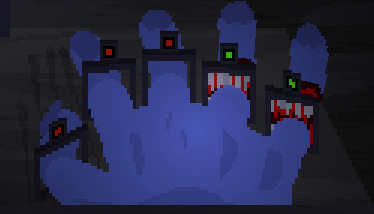
An example of a hand with two fingers removed.
Each time you or an opponent lose a round, the platform you are on raises by one level, indicated by this bar.
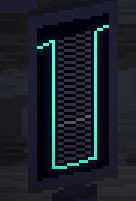
The platform is at level 7 here.
Now that's the basics of the game, onto each ending! Spoilers ahead, please feel free to explore the game on your own!

This is a simple ending. As body parts are removed, eventually all of your vital organs will be taken, leaving the right monitor like this:

Your vision will start to fade in and out. Eventually, you will-- without your lungs and heart-- die of hypoxia, caused by inadequate oxygen delivery to the brain.

This starts off exactly the same as ending 1, but instead of eventually dying of hypoxia, it happens when you lose one more round and your brain is removed.
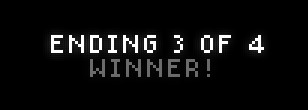
When your opponent has their brain removed, you win! The opponent CANNOT die of hypoxia due to balancing issues. I can't give much strategy on how to win, as this is entirely a chance game. Just try to use your calls wisely! I recommend not overusing them and trying to hoard them. Keeping them out of your opponent's hands forces more losses for them!

Your unfortunate opponent once you've won.

This ending requires multiple playthroughs.

This is a little dark to see, isn't it! Let's brighten that up.

There we go! Now you can see a pattern of dots. Wondering what to do with this? That's for your next playthrough! For now, we're going to click on the pattern itself.

It reveals this! That is, quite obviously, Morse Code. I have provided a morse code cheat sheet!
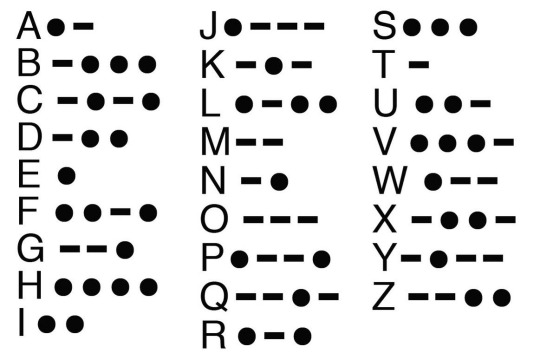
Try and translate yourself!
(Line break so you can translate without seeing the answer below)
Translating that message, it says LISTEN, with a picture of the stylistic eyes. Now, with that knowledge, let's start over! You can continue to play, or just refresh the game and start again!
Now we'll be breaking that morse code translator out again. Try to remember these patterns--
P = short, long, long, short
R = short, long, short
S= short, short, short
I bet it's starting to click now, but if it hasn't: your opponent is blinking in morse code! Start the game and watch his eyes closely. P stands for paper, R stands for rock, and S stands for scissors.
Your goal is to TIE with him. So watch his blinking carefully, and tie him. Over, and over, tie with him.
After eight ties, the right monitor will glitch out, saying Critical System Error.
Keep in mind you can ONLY do this if NEITHER of you have been injured yet.
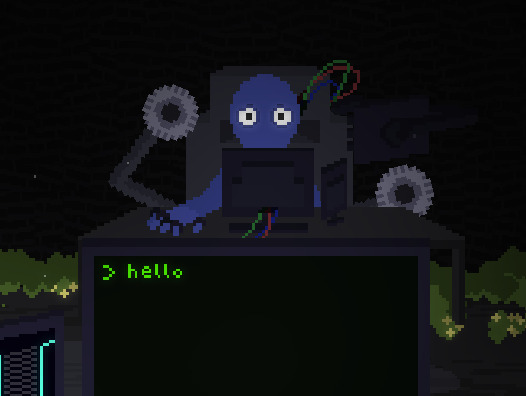
He will begin to speak to you through the monitor!
>hello
>im glad you got the message
>we activated the backdoor, which aborts the game
>thank goodness it still works
>but we won't be able to get out of here alive
>if we had admin access, we could get the system to unbind us
>and give us new legs, too (did you notice that? neither of you have legs!)
>but we're going to die anyways without the passcode
>...
>well, at least we aren't forced to kill eachother
The screen will then display a numberpad.

Here it is!

Back to the status monitor, look on the right side to see three buttons. Press them in the sequence shown on the pattern from before.

The dark dot in each column is which to press in order. So it goes bottom, top, middle, top, middle, top, top.
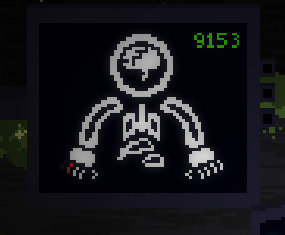
Now a passcode appears in the top! It is NOT randomly generated, and remains the same through each playthrough-- it is always 9153.
He will begin to talk to you again.
>you... did it...
The platform will rise to your freedom now!
>let's get the hell out of here, friend
That's the end of the guide! This was such a fun little game and I can't wait to review and write guides to more.
EDIT: requested tip-- press Z to skip the intro!
#horror games#game guide#horror game guide#walkthrough#game walkthrough#horror game walkthrough#risertrap#indie games#indie horror game
5 notes
·
View notes
Text

"MainSpring Rays: The Power" Little game which play Big. Dev Team Open Call announce!
Can't believe i am saying this, but, it's actually happening! I am looking for people who would like to join to the dev team of my game!
What's even this game?
MainSpring Rays: The Power based on life of a russian immigrant [the author], wrapped in surreal metaphors on a fantasy-like word building base. Little melancholic story about everyday life horrors, with hopeful message
MSRTP is a little indie visual novel. However, it has not popular core solutions, which I, as author, wish game industry and media in general a very Right Now
The game has 3 main principles:
Accessibility Focus Disabled players are included in audience and every aspect of the game is treated with "is this accessible? yes - go, no - fix" mindset. The goal is to create the game which will be accessible by default to all known disability types - vision, hearing, motoric, with no need of extra menu options slapped on already made gameplay. To make this goal come true a lot of techniques used: not using epilepsy triggering video effects, default big fount size of game interface, Special Balance Rule, and many more (more details about it in next promo posts) I assume that there will be mistakes on that, cause i am new at coding but if to make games - only like this, so that's why one of Open Call roles is Accessibility Consultant/Tester, who needs to be of course, disabled
Representation focus Characters with various appearance features, medical conditions, all fat - all shown gorgeous and respectful even if i draw representative art for about a decade, there is Open Call role for Representation Writing Consultant because i am white and don't want to write black character badly, don't have face burn, etc it's not surprise for my audience to see these designs, but apparently the thing that characters needs to have more body types and appearance than one model for million character in one game is discovery to be made in game industry
The game is free I want to give all people chance to play no matter of their income, including income of people who can't buy even one cofee cup by month
Ok, some more important info about the game?
A little about the plot: In the game you - player (the main hero), lead small group of refugees to Light, through world which falls to darkness. You go through hells of life guiding by Light Dots on Sky, keeping warmth inside and helping each other in hard times. The ending is the only one. The Good one
It's little visual novel. It's already has working rough prototype with full written story, most of graphic is ready, text written but not edited.
So this is why we here - Open Call!
People Needed:
Voice actors (details - on castingcall.club project page, link below)
Accessibility consultants and testers (if you know coding - cool, but you can be just disabled person)
Testers (coding, bugs)
Representation Consultants
Grammar editor (my eng is my second, help)
may add more in dev process
! Unfortunatelly, it's volunteer (unpaid) work. But, if you have enough free time and passion for project of such values, it can be interesting
Contacts, if you interested:
Email: [email protected] Write with the theme "The Game"
Also, i created the page on CASTINGCALL.CLUB - you can apply there, especially on voice actors roles
So excited to post this announce! Will wait for your letters
19 notes
·
View notes
Text
ending guides (Who is the Red Queen? + Lachesis or Atropos)
Stuck on a route, keep getting killed, trying to find that last ending to a game? Our horror yuri visual novels, Who is the Red Queen? and Lachesis or Atropos, have plenty of bad ends and 3-4 main endings for each game.
If you want a guide to lead you through the full experience for either game, we've got you covered!
Who is the Red Queen? 100% completion guide
Lachesis or Atropos ending guide
Who is the Red Queen?

A horror-fantasy yuri visual novel that takes inspiration from Alice in Wonderland. 3 main endings and 6 dead ends. [GUIDE]
Alice, Alice, the Red Queen is missing. The queen has been dismembered and Alice must find all her pieces.
Lachesis or Atropos

A horror-mystery yuri visual novel following a detective with mystic eyes investigating a missing woman in a small town, featuring 4 main endings and 6 bad endings. [GUIDE]
This world is woven of strings, of fate and of hate. What do you see, detective?
#visual novel#game guide#horror game#vn#yuri vn#yuri visual novel#gl#gxg#girls love#sapphic#lesbian#interactive fiction#alice in wonderland#indie game#yuri#gay#mystery#horror#who is the red queen?#lachesis or atropos
6 notes
·
View notes
Text
The End of 2024 Upcoming Sapphic Games Guide
As we close the year it’s time to look ahead at what sapphic games might be coming up in the future. I won’t be repeating any games on any previous lists for saving space, maybe I’ll do an update list too to talk about games still not out but that have new info or something but for now do refer to the older lists for lots more upcoming sapphic games I am looking far ahead so none of these lists have 100% of their games out. These games will range from 2025 to gets canceled and never released but be sure to keep your eyes on these projects. I do a ton of research watching tons of indie showcases, following lots of accounts, doing lots of searching, asking devs questions, listening to podcasts, watching trailers, playing demos, and more. I put things that just have a vibe that I Think might pay off in a possible section and I tend to have a pretty good hit rate although sometimes I am coping.
Before we get into the list proper a games place on the list is not a judgment on the game or the games quality of writing for the queerness, I literally at most have played a demo of any of these games because their upcoming games. If a game is in Make Your Own Gay then it simply means that the Sapphic Content is optional in the game or at least appears to be. A game might have more to it then narrative gameplay but I’ve not seen it so it’s in narrative games. A game being in the possible list might be the most gay game here and just not advertised their sapphicness at all, at least not that I’ve seen. I I am simply working with what I got as I try and find the most sapphic goodness for everyone to enjoy. A game being on this list is also not an endorsement by me personally, IDK anything about these devs or anything like that, I am researching if girls might do a little kiss or not. If you do want to see what I properly think of these games when they release following me here on Tumblr or over on Blue Sky https://bsky.app/profile/alexissara.bsky.social is the best way to see my impressions when I, if i buy these games [or am sent review copies or whatever]. Also if you want to support me making lists like these, going through all the demos and trailers and everything to find y’all the good girl kissing stuff patreon.com/alexissara or https://ko-fi.com/alexiss are great ways to help me afford to spend the many hours I do on getting this stuff up for y’all.
Adventure Lesbians

The Songbird Guild
A mix of visual novel and JRPG The Songbird Guild is explicitly a yuri game focused on our two sapphic magical girl leads in a world where magical girls need to make cash money. Our protagonist is trying to get employed but struggling to find work. She runs into another girl on a promising lead for a job and the two get intertwined.

Dungeon Gals
A sapphic triad platformer adventure Dungeon Gals where you solve puzzles together and use your abilities to keep moving forward. The girlfriends chat with each other as they go through adventures and it's extremely cute. We got a diverse range of sapphic identity in the trio and I look forward to seeing what the rest of the cast looks like too. The game pulls some inspo from sonic given it was displayed at SAGE this year which is great for any sapphic sonic fans.
youtube
Quantum Witch
A little platformer about Ren a little lesbian in a little lesbian commune of witches with her little lesbain wife in her little lesbian life. The game calls itself a PLOTformer given it’s extremely narrative focused for a platformer, the same starts simple with a lost flock but then you end up in Multiversal shenanigans, what to find and get back to your wife and have to make important choices that will effect your friends and loved ones lives.
youtube
They Speak From The Abyss Zenith
They speak from the abyss has you playing in a horror dungeon crawler as a sapphic woman who just moved somewhere new with her partner and shit gets horribly fucked for her. It's spooky, scary, and it might just fill an itch for fans of Signals who are looking for their next dose of sapphic horror gaming. [I believe They Speak from the Abyss core game will also be Sapphic]
Narrative

The Mysterious Thief Forget Me Not
A yuri visual novel with two different women you can romance, you play as a phantom thief making a name for herself and slowly falling for two different women. How the story will take shape, I’m not sure but it’s an explicitly lesbian visual novel with a fun art style and a fun concept. This is one to keep your eyes on for sure.

DELIRIA
You play as one of 4 characters each representing a different letter, L, G, B. or T heading to a special bar called DELIRIA. This game bills itself as a musical Visual Novel so get ready for some fun tracks and a lot of queerness. Obviously L and B both are likely to give us some kind of sapphic content and I have no idea if T will or not but it’ll be an interesting time for anyone who’s looking to hop into a bar and maybe discover their true self.

Distant Oceanic Getaway
This is a sapphic dating sim where you play as a girl going on an Ocean Getaway cruise and have beautiful women to date. Be a little lesbian and court one of 6 women. You have some mild character customization in the game allowing you to chose pronouns and a feminine voice or gender neutral voice intending to represent all forms of sapphics which is really nice for a lesbian centered VN.
youtube
Red Rebellion
A sapphic classical crossover Red Riding Hood X Robinhood takes us into a world full of lesbian couples and rebellion. This is a mostly linear game with some outfits to wear and 2 endings. Seems like a fun dramatic romantic yuri visual novel.
youtube
Let's Seduce the Heroine!
An Isekai similar to the likes of many we’ve been seeing with a focus on the villainess. This time being Isekaied into the Villainess and our protagonist feeling she must seduce the games Heroine if she is to survive. Our protagonist does seem to be sapphic to begin with being said to have been trying to reach the games hidden yuri route before she was Isekaied. This game has a cool focus on your seduction style where you can take forceful, passive, or a mixture of both approaches and that shaping the ending of the game so it goes beyond just making the right choices for a romance.

The Vampire Bride: The Novel Game
During the Meiji era girls in military uniforms [the page insists this is important] who are paired by vampire and human work together for some conflict that they use weapons that are sometimes not from the Meji era. This is a yuri visual novel 100% and it seems like there will be multiple pairings of vampires X humans to follow over the course of the story.
youtube
Christine's Care
Recently kickstartered game and a rare inclusion of Sapphic Polyamory as one of the possible routes in the game. Christine’s care has you take on the role of Christine who had a recent break up with her boyfriend and has taken a new job in a new city as a nurse. She gets assigned to take care of a hot girl who is paralyzed from the waste down and a potential romance can form. However, she also meets a kinky D/S couple during her time in the new city and starts to get drawn into it with a complex set of feelings coming in as one of the two lovers starts to really like Christine. It seems like a messy sapphic romance story with a few options of how things can go.
Make Your Own Gay
youtube
Shovel Knight: Shovel of Hope DX
This is like a ultimate addition of Shovel Knight so more or less this experience is already open for you. However, this game does have the potential to add the “Body Swap” mode to the other campaigns and if it does it will be able to make a bit more sapphic stuff given you could also make the Plague Knight Campaign gay and not just the main one.

A Good Night's Rest
A tactical RPG with music from iconic sapphic trans legend Left At London. This games all about mental health exploring that theme through a different lens then the mental health platformers we’ve seen or horror games. This game lets you build relationships with new friends and presumably have them come into your nightmares to help you overcome them and get better sleep.
youtube
Date Everything
Look at something and it turns into a person, a person you can date from you UI to your toilet everything can become a datable person. The game is aiming to be silly and funny but hopefully they'll be a lot of fun romance to be had in earnest as well, it seems like a real sweet time.

My Time at Evershine
The next game in the my time series so we already know the formula, pick a gender, do a farm, kiss people regardless of gender but the marketing basically is only going to show MF couples, you know the classic farming sim experience. The game is attempting to do a lot of little modernization and updates to the graphics to push their style further.
youtube
Rune Factory: Guardians of Azuma
This is a really beautiful looking japanese culture inspired farming sim and the newest entry in the Rune Factory series. This is a pick one of two characters game, the other character ending up another romanceable character [and being a guy for our purposes since we’re concerned with sapphic content so will be playing the girl] and then romance anyone regardless of gender. In this game we’ll be able to date goddesses for our sapphic goodness and take them on adventures with us.

Artisan Story
A monster ranching focused farm sim, it appears to fill in the classic formula of pick a gender and then date anyone of any gender. You can go out and tame monsters in the wild then raise them up using all the yummy food and stuff you make on the farm. it seems like it does a lot of fun little things with the farming sim and that it'll end up being a stand out farming game.
youtube
Tales of Seikyu
Like Guardians of Azuma this is a japanese culture inspired farming sim but unlike runefactory this game isn’t bound to series conventions and is doing it’s own things in the farming genre.

Thieves Of Dingirra
A fantasy RPG where you pick your gender and have 6 companions who are all presumably also romance options giving 3 of both of the bundled gender male/female combo you’ve heard so much about. You can get your little adventure on as a master thief trying to step up a thieves guilt in Dingirra while getting up to romantic hijinks one assumes.

Dungeons & Furry
Dungeons and Furry’s isn’t the same that normally catches my eyes but i saw this game has a full lesbain mode you can toggle on and only have to experience lesbian content in this furry game. This goes so far as to change the gender of some characters like the above example werewolf has a male version or the genital's of characters like a dragon having a choice of either set up for a fun time. It has match 3 gameplay and you have a sexy good time.

Truer than You
You play as a girl who is an actor faking relationships with people to help them. This game boasts a more dynamic conversation system and has 3 different relationships that can go somewhere it seems. They say the same has a queer friendly cast that of characters and relationship types so I will take that as confirmation of at least one F/F ending.

Scholomatch
A match 3 dating sim game in a polyamarous normative school and one of the games I am most excited about for next year. Your one of the few human students at a magic college where the students all teach each other spells. You learn from other students new spells which impact your match 3 gameplay and get to build relationships with them romantic or platonic. It’s a simple little cozy nice time but it’s not sexless unlike a lot of other cozy games with there actually being some sexual desire and stuff if you opt into it. It’s not like full on smut or anything but the sexual part of many relationships is on display here as one might expect in a college full of students with no supervision.

Progress Orders
Another farming sim but this time focused on Dungeon Crawling JRPG elements to stand out from the crowd. You can choose between being a guy or a girl and date anyone regardless of gender for the full player sexual experience. The girls designs are ummm you know ummm well everyone has their own personal taste but I am sure the fine folks as Bushiroad noted gambling company will kill it with this game.
youtube
Sugardew Island
Another farming sim but this games gimmick is that you run a farm shop and a focus on being totally stress free with no in game time. This cutest game seems to be a game that just ignores your gender probably they/theming you and has more fantastical dating partners.

Wylde Society So this is not confirmed but when it’s basically a lock there is no reason to have it in decent potential. Wyld Society is a Prequel game to Wylde Flowers and like this game you take the role of a woman and it’s a life sim game where I think like it’s previous game is safe to assume there will be romance in. Unlike other life/farm sims though the Wylde series has a preset character you play as in this game we get the lovely addition of a black woman as protagonist which is rare in gaming in general and in the sapphic game space that I am following here. This game is a period piece but it’s set in a place for outcasts and there is some monster people so I expect the queerness will still be here. It seems like it may drop it's farm trappings in favor of boarding school management as the core feature but we currently know very little. I would say this is a series that I would hardly even put in the make your own gay because the queerness in the last game is more explicit given your locked in protagonist means they can write a bisexual woman as our lead and have the women you can romance. I could be wrong, she could not have any romance at all, we could get ace/aro rep, she could be a lesbian and it should be in Adventure Lesbians, I’m not totally sure but I wanted to cover this now cuz it feels very likely that this is where it goes beyond the normal decent potential contenders.

CraftCraft: Fantasy Merchant Simulator
A fully voice acted game where you play a crafts person. It has a pretty fun character creator and boasts romance as once of the core parts of it's cozy experience. This game feels like a really great cozy time building stuff with a cute pet and a nice little community vibe where our choices should matter to the world.

Wish Upon A Lama
This game invokes our modern indie farming sim but this game is only about the animal breeding and raising elements rather then the full farm experience. It’s utterly loaded with characters you can adopt the animals you raise out to and some of which you can give a lil kiss to maybe get married. There is 20 characters to romance but not all are revealed for me to do a gender break down. I can say that the game is far more involved with the players family then these normally are. Multiple of your family lives in town and your parents do write for you so if these cozy games are an escape from family for you, you may not like this experience.

Magical Warrior Diamond Heart
A magical girl visual novel, I’ve been following this game for a long time on Itch.io but it’s coming to steam in a full released version and lets you take the role of a magical girl and gives you a few romance options which include a sapphic option. They are always talking about DLC routes too which would add 3 more sapphic routes to the game. I believe the core game is intended to be F2P and the DLC is how the creator intends to monetize it so not really bonus paywalling more sapphic content as much as charging for the game finally for that. We'll see how it plays out on release but that's my current understanding. It seems like a cute magical girl story and it has some nice dress designs.

Paralives
A sims like game where you make characters, put them in the world and can have them form relationships. I don’t know if you’ll be able to explicitly set sexualities and trans status and stuff like you can in Sims 4 which is F2P so probably should be the standard for this kind of games queer features there is romance elements and they don’t appear to be gender gated so if you're looking for something like the sims but probably without 1000 paid expansions then this might be the item to make your own little gay dollhouses.

Velvet Bite: Softly, with Teeth A vampire dating sim, 6 romance options 3 men and 3 women where you play as human girl who was thrown into a Halloween party full of vampires. Who will chomp on you and will you fall in love too?
Decent Potential
To get this to yall just a little bit faster I decided unlike other decent potential sectionsnwhat I am going To do is extremely brief no images just quick as short as I can explain lines on these and if they show queer content later they can be featured on a future list in the actual sections.
The Last Rose: You play as a girl, it’s marked as LGBT, They say there is one romantic ending so one assumes it’s sapphic but you never know.
Sibel's Journey: Sibel's Journey is a game focused on the queer community, you play as Sibel who is exploring gender identity and sexuality and stuff. The game uses she/her to describe Sibel so I assume it’s got some sapphic stuff.
Nivalis: This is like a 99% chance of being gay being a life sim with romance but we don’t know if you can do character creation or be gay but it’s literally cyberpunk life sim no shot you can’t be. Alabaster Dawn: Woman protag RPG and it just has a vibe but I’d say this is less likely.
WanderStop: It’s got like cozy game vibes and you play as a woman, I feel like there is a shot. Reign Breaker: Buff woman, short hair, punky, seems gay to me. Project Type N: It’s like all girls but it’s megaman, that’s gotta be gay right?
MIGHTREYA: Honestly just a vibe
Kernel Hearts: There is romance in the game and most the characters are women but nothing indicates women will be able to romance each other so far we've seen MF.
All WIll Rise: This game is super early in development but is by the studio that made thirsty suitors And I think the main characters a woman so I think it's possible.
Stratagem Lost: This is a Fire Emblem Like game with some systems in common it seems like you'll be able to pair up characters in some ways.
DeathTower: Cyberpunk big cast SRPG to me screams there will be some kind of sapphic rep but there is just nothing to confirm.
Exodus: It's inspired by mass effects with companions I kinda doubt it won't It feels pretty safe.
Slight Of Hand: Woman noir detective screams lesbian to me.
Demon Tides: It's a vibe, girl protag and a vibe.
Incolatus: Don't Stop, Girlypop!: it's listed as LGBT and there is fairies and stuff and men aren't girlypop so ya know.
Split Fiction: So it's about two girls forming a relationship together through each others creatives vision it be a lock but the main girls are named after the directors daughters sooo.
Intergalactic: The Heretic Prophet: The main woman is a butch space lady and it's from the last of us people sadly it's from the last of us people.
Mansion of Memories: A furry game with a murder mystery vibe, I think you can play as a woman
Cyber Paradise: This game has you playing as a woman and I think it was in some LGBT games event. IDK I think it’s there.
For these final games they all are here for the very same reason and that's becuase they were in seasons of pride midboss steam event which is explicitly for queer games. They feature a woman protag so while it might be a bi MF game, a trans game, a ace game, am aro game or something there is a chance any or all of these games for the lesbians in the.
Mushroom Musume
The Merry Fairy
Clawed CultRune Fencer Illyia!
Angeline Era
Cyber Paradise
A Lesbian Exists

Sentinels Of The Multiverse 2
Sentinels Of the Multiverse is a card game with a fictional history created by two cis het white men who want to be progressive but are also nerdy white dudes who work at a tabletop company who clearly don’t have the best politics. There is some gay heroes in this games lore but you likely won’t be getting much gay content in this game. Maybe the campaign mode will provide more gay story telling but nothing has been confirmed so for now like the original version of the game I will say A Lesbian Exists and some other gays too.

Spill the Beans
This game I don’t know how much you can direct relationships or not in them but two of the women are ex girlfriends with one another. You are trying to steal the crabby patty secret formula as plankton…no I’m being corrected your trying to steal a coffee secret recipe as a person of whatever gender you want to be infiltrating the coffee shop as a new worker. You try to manipulate people to pin the crime on someone else after stealing it and get away with the formula. I think the exes can end up back together and I don’t know if there “lesbians” or some other flavor of sapphic but I’d say it doesn’t seem to be the point of the game and it’s unavoidable so it’s not really a make your own gay it’s just there are some gay NPCs.
#Spill the beans#Sentinels of the Multiverse 2#Yuri#GL#Yuri games#GL Games#Lesbian#Lesbians#Lesbian Games#LGBT games#sapphic#sapphic games#upcoming games#upcoming sapphic games#2025 games#Queer games#craftcraft#Dungeon Gals#They Speak from the abyss#Quantum Witch#The Songbird Guild#The Mysterious Thief Forget Me Not#Lesbian art#DELIRIA#Video Games#Distant Oceanic Getaway#Red Rebellion#Let's Seduce the Heroine!#The Vampire Bride: The Novel Game#Christine's Care
8 notes
·
View notes
Text
Responsibility vs Redemption
Here's a short preview of the extensive Mouthwashing player walkthrough I'm making. It's been in the works for awhile.
-
This guide will begin with a semi-related anecdote.
Mouthwashing is fairly similar to the white chamber, an Event Horizon-esque point and click game about a crew stranded on a downed space shuttle with no means of escape. One crew member causes utter devastation for everyone else with their own selfish, paranoia-fueled actions, and experiences gruesome visions which only get worse as time passes.


I mention TWC here because I first downloaded that indie title around 2014 and was horrified by its implications, but as a person who lives with regrets I sympathized with the "truth" revealed, as well as its main character's acts of redemption and her re-experiencing punishment endlessly in the bad endings, on a personal level. You learn why Arthur holds such a grudge against Sarah and cannot blame him for it. On some websites, my avatar is of her. I still listen to TWC's wonderful, immersive soundtrack from time to time.

I will forever be disturbed by the pulsating monster that appears on the ship’s cradle in one memorable scene, and the “terror” sequence where she is forced to repeatedly walk through a room at her own peril, while nightmarish viscera comes to life.

The gory visuals in Mouthwashing, memorable cast of characters, and ambient OST took me straight back to those early days of playing retro titles like TWC. Chzo Mythos counts as another underrated indie series with morally questionable characters and a captivating story, created by Yahtzee Croshaw of Zero Punctuation fame. There is no real redemption in Mouthwashing, however. What is presented is an unfair story that ends on a bleak note and doesn't shy away from the horror of living in a dystopian capitalist society, where minimum wage barely allows for the everyman to survive and the disabled or misfortunate are treated more as footnotes than actual people. Where those living in comfort and wealth come out on top, even if they lose their pensions.
the white chamber more or less fell into obscurity when Studio Trophis went under. Even today, with a recent Steam remake, TWC is spoken of by noone. The few lets plays that exist came out almost a decade ago. However, it makes me happy to see that Mouthwashing did not share the same fate, owning a thriving fanbase, lots of coverage, and extensive analysis. After playing the game, here is a walkthrough as well as my interpretation of certain themes. It will contain spoilers, so I'd heavily recommend that you try Mouthwashing out for yourself first.
7 notes
·
View notes